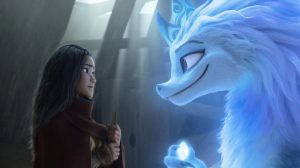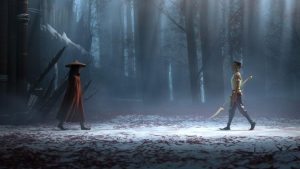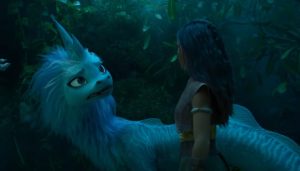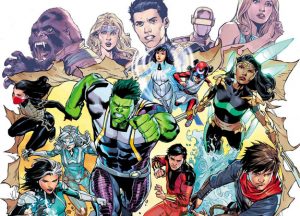There was a time when Disney had me convinced that Raya And The Last Dragon would be heavily rooted not only in Southeast Asian culture but in the region’s various unique mythologies…and while to some extent that is true and Raya does pull from many sources (too many, some have argued), the final product is to the best of my knowledge an almost wholly original story, having no basis in any specific myth or legend, and inventing more monsters and mythical creatures than it borrows from local folklore. Does that disappoint the mythology buff in me? Well, yeah, but also no – because what we get instead is an ingenious, beautiful, and almost eerily timely story of division and human failing in a time of unprecedented chaos. Sound familiar?

Disney’s darkest animated movie in years, Raya wastes no time setting up its tragic tale. Set in a sparsely-inhabited dystopian world named Kumandra, where most humans have been transformed into stone by a swarm of unearthly black tumbleweed called Druun, the film never sugarcoats the feelings of fear and confusion that keep most of Kumandra’s survivors locked up in their individual castles and kingdoms, protected by shards of the magical Dragon-Gem – the only thing, besides water, that can repel the onslaught of the Druun, which have ravaged most of the land’s forests, deserts, and mountains. Splintered into factions representing parts of the Last Dragon (Fang, Heart, Talon, Spine, and Tail), Kumandra has been trapped in this unsustainable status quo for six years, since a clash between Princess Raya of Heart (voiced by Vietnamese-American actress Kelly Marie Tran) and Princess Namaari of Fang (Gemma Chan) led to the breaking of the Dragon-Gem and the ensuing power struggle over its fragments.
But Raya And The Last Dragon is the rare dystopian epic that doesn’t aim for a gritty or grungy aesthetic – in fact, it’s a vivid, colorful masterpiece of animation, a particularly admirable feat given how much of it was created at home during the height of the COVID-19 pandemic. Every detail, from the diverse and unique character designs down to the food they eat (be warned, this film will make you hungry) looks lovingly crafted and real. Even the parts of Kumandra that have been overrun by Druun are hauntingly beautiful, dotted by rows upon rows of eroding statues.
Visual splendor was never the chief selling-point for Raya, which perhaps misleadingly billed itself as an intense action film. There are fight sequences, all very fast-paced, well-choreographed, and intensely violent without so much as a single drop of blood being spilled (give us the R-rated cut, Disney!), but they’re not exactly frequent. That being said, they’re elevated by the distractingly beautiful settings in which they take place, and the array of unique weapons being used. For instance, what I thought was a dragon-mace in the first trailer was actually a glimpse of Raya’s sword, which transforms into a significantly cooler bladed whip. Namaari, her main opponent throughout the film, rides into every battle on a giant cat.
Speaking of which…am I the only one getting Catradora vibes from the occasionally flirtatious banter between the two women every time they clash, or the dynamic at play in their complicated relationship? I mean, even Kelly Marie Tran wants us to know her Disney Princess is unofficially gay. Raya And The Last Dragon is arguably Disney Animation’s gayest movie yet, which of course means that every interaction between the protagonist and antagonist is technically platonic, in the same way Elsa and Honeymaren’s interactions were technically platonic in Frozen II. But there’s something about their relationship still being the real thematic core of the entire movie (not to mention a myriad of “JUST KISS ALREADY!” moments, and every time they refer to each other as “dep la”, which roughly translates to “strangely beautiful” in Vietnamese) that makes me feel like Raya might have been more overtly queer in the writing process. It’s worth noting that, while there are several metaphors for broken trust throughout the film, including the shattered Dragon-Gem, it’s Namaari’s dragon-pendant – a gift to Raya – which ultimately best symbolizes that theme, representing not just Kumandra itself, but the most painful betrayal in Raya’s life.

The pendant is but one of many small details incorporated into the film – separate from the incredible level of detail in the animation I mentioned earlier – which flesh out Kumandra’s extraordinary world, although loosely borrowing/blending bits and pieces of various Southeast Asian cultures is not a strategy without its faults, particularly since the film didn’t put in the work when it came to representing Southeast Asian voice talent. Each region of Kumandra is at once unique and different (I’d love to explore more of Talon’s colorful floating markets in a Disney+ series), but the people and their cultures clearly influence each other across borders: particularly through their food, and through a shared reverence for the Dragons of ancient lore, still visible in their most common greeting – forming the shape of the Dragon-Gem with one’s hands and lifting it above one’s head to denote respect. Little things like this subtly make Kumandra one of the most realistic worlds in Disney Animation.
The titular Dragon, however, is probably the film’s most controversial element – since Awkwafina’s shapeshifting Nāga Sisu doesn’t fit entirely comfortably within the otherwise somber story, and she’s never actually treated with much reverence, either by the characters in the film or by the film itself, which uses her as the butt of some fairly lazy jokes. Her design is also a rare misfire: with a disheveled feather-boa mane and a head that looks far too large for her serpentine body, Sisu looks awkward rather than awe-inspiring, only vaguely capturing the majesty of Southeast Asian water dragons as depicted in art and folklore for centuries.

But considering that its only other major misstep is a pacing issue and a blurriness between acts that makes the story feel rather more episodic than epic, I believe Raya And The Last Dragon is strong enough to kick off a new age of Disney Animation movies marked by more complex and mature storylines, and a lack of music I never once missed (until now, because I suddenly wish Namaari had a Disney Villain song gradually transitioning into a poignant romantic ballad).
Rating: 8.5/10
